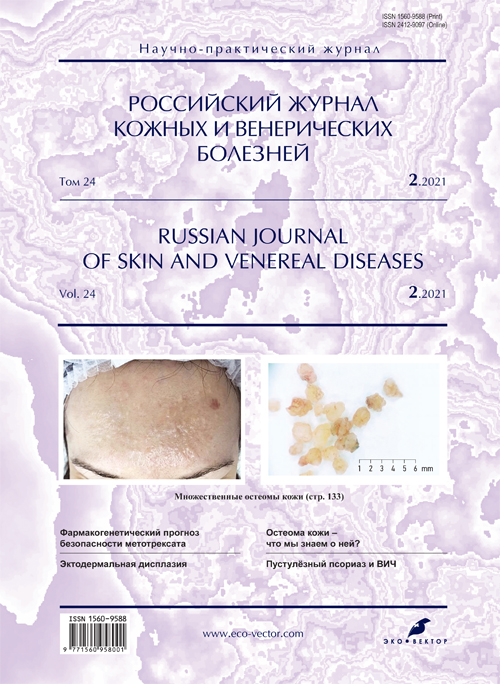Клинический опыт наблюдения и тактика ведения пациента с эктодермальной ангидротической дисплазией
- Авторы: Старцева Е.Ю.1, Боброва О.В.1, Летяева О.И.2, Зиганшин О.Р.1,2, Закомолдина К.К.2
-
Учреждения:
- Челябинский областной клинический кожно-венерологический диспансер
- Южно-Уральский государственный медицинский университет
- Выпуск: Том 24, № 2 (2021)
- Страницы: 179-186
- Раздел: ДЕРМАТОЛОГИЯ
- URL: https://bakhtiniada.ru/1560-9588/article/view/64274
- DOI: https://doi.org/10.17816/dv64274
- ID: 64274
Цитировать
Аннотация
Понятие «эктодермальные дисплазии» охватывает группу редких наследственных аномалий развития, имеющих многообразие фенотипических вариантов, но характеризующихся общими признаками недоразвития или аномалийного формирования органов и тканей, производных эктодермального листка (кожа и её дериваты ― ногти, волосы, зубы, нервная система и органы чувств). Примерно 25% известных до настоящего времени эктодермальных дисплазий наследуются по аутосомно-доминантному или аутосомно-рецессивному типу, в остальных случаях тип наследования невыяснен. Синдром характеризуется широким спектром клинических проявлений и может включать дополнительные симптомы поражения других эктодермальных, мезодермальных и эндодермальных структур. Эктодермальные аномалии ― проявление нарушений в пространственно-временной координации в ходе развития эпидермиса. В них участвуют такие гены, как EGF (эпидермальный фактор роста), ЕD1 (эктодисплазин), EDAR (ангидротический рецептор эктодисплазина 1) и другие, активирующие или подавляющие факторы транскрипции (в частности рбЗ; Koster). Выявлено пока лишь около 20% генов, отвечающих примерно за 200 эктодермальных дисплазий различной симптоматики и степени выраженности.
В статье описывается клиническое наблюдение пациента с редким заболеванием ― эктодермальной ангидротической дисплазией. Представленны данные литературы о клинических особенностях течения дерматоза, в том числе у описываемого нами пациента.
Ключевые слова
Полный текст
Открыть статью на сайте журналаОб авторах
Елена Юрьевна Старцева
Челябинский областной клинический кожно-венерологический диспансер
Email: hron_derm@chokkvd74.ru
ORCID iD: 0000-0003-3987-6176
Россия, 454048, Челябинск, ул. Яблочкина, 24
Ольга Валерьевна Боброва
Челябинский областной клинический кожно-венерологический диспансер
Email: frantseva.olga@list.ru
Россия, 454048, Челябинск, ул. Яблочкина, 24
Ольга Ивановна Летяева
Южно-Уральский государственный медицинский университет
Email: olga-letyaeva@yandex.ru
ORCID iD: 0000-0002-9085-6229
SPIN-код: 3312-3150
Россия, 454092, Челябинск, ул. Воровского, 64
Олег Раисович Зиганшин
Челябинский областной клинический кожно-венерологический диспансер; Южно-Уральский государственный медицинский университет
Email: ziganshin_oleg@mail.ru
ORCID iD: 0000-0002-5857-0319
SPIN-код: 5339-2533
доктор медицинских наук
Россия, 454048, Челябинск, ул. Яблочкина, 24; 454092, Челябинск, ул. Воровского, 64Ксения Константиновна Закомолдина
Южно-Уральский государственный медицинский университет
Автор, ответственный за переписку.
Email: ksinja@mail.ru
ORCID iD: 0000-0003-4699-9465
ординатор
Россия, 454092, Челябинск, ул. Воровского, 64Список литературы
- Галонский В.Г., Радкевич А.А., Шушакова А.А., Тумшевиц В.О. Эктодермальная дисплазия: характерные клинические признаки и методы стоматологической реабилитации//Сибирский медицинский журнал. 2011. Т. 26, № 2. С. 21–27.
- Ramraje S.N., Wasnik M., Momin Y.A. Anhidrotic ectodermal dysplasia – a report of two cases. Bombay Hospital Journal. 2009. Vol. 5, N 12. Р. 121–129.
- Хёгер П.Г. Детская дерматология / пер. с нем. под ред. А.А. Кубановой, А.Н. Львова. Москва : Издательство Панфилова; БИНОМ. Лаборатория знаний, 2013. 648 с.
- Козлова С.И., Семанова Е., Демикова Н.С., Блинникова О.Е. Наследственные синдромы и медико-генетическое консультирование: справочник. Ленинград : Медицина, 1987. С. 261–262.
- Иванова И.Н., Сердюкова Е.А., Иконникова Т.И. Ангидротическая эктодермальная дисплазия//Российский журнал кожных и венерических болезней. 2012. № 3. С. 17–19.
- Козлова С.И., Демикова Н.С. Наследственные синдромы и медико-генетическое консультирование: атлас-справочник. Москва: Товарищество науч. изданий КМК, Авторская академия, 2007. С. 308–309.
- Миронова О.Б. Секвенирование как метод детекции мутаций гена, кодирующего эктодисплазин-А, при диагностике Х-сцепленной формы ангидротической эктодермальной дисплазии//Прикладные информационные аспекты медицины. 2017. Т. 20, № 4. С. 14–17.
- Зеленова М.А., Ворсанова С.Г., Юров Ю.Б., и др. Дупликация гена EDA у мальчика с расстройством аутистического спектра и задержкой развития: молекулярно-цитогенетическое, биоинформатическое и психологическое исследование редкой геномной патологии//Международный журнал прикладных и фундаментальных исследований. 2017. № 7-1. С. 97–101.
- Lingling H., Williams M.S., Spritz R.A. A Gene for autosomal dominant hypohidrotic ectodermal dysplasia (EDA3) maps to chromosome 2q11-q13//Am J Hum Genet. 1998. Vol. 62, N 5. Р. 1102–1106. doi: 10.1086/301839
- Торгашина А.Г., Фирсова И.В. Симптомокомплекс эктодермальной дисплазии в клинике стоматологии//Бюллетень медицинских интернет-конференциий. 2013. Т. 3, № 3. С. 745–747.
- Беляков Ю.А. Наследственные заболевания и синдромы в стоматологической практике. Москва : Ортодент-Инфо, 2000. 294 с.
- Pipa V.A., López A.M., González G.M., et al. Treatment with removable prosthesis in hypohidroticectodermal dysplasia. A clinical case//Med Oral Patol Oral Cir Bucal. 2008. Vol. 13, N 2. Р. 119–123.
- Олисова О.Ю., Владимирова Е.В., Бабушкин А.М. Кожа и солнце//Российский журнал кожных и венерических болезней. 2012. Т. 15, № 6. С. 57–62.
- Коминек Я., Томан Я., Розковцова Е. Детская стоматология. Прага : Государственное издательство медицинской литературы, 1968. С. 417–418.
Дополнительные файлы










